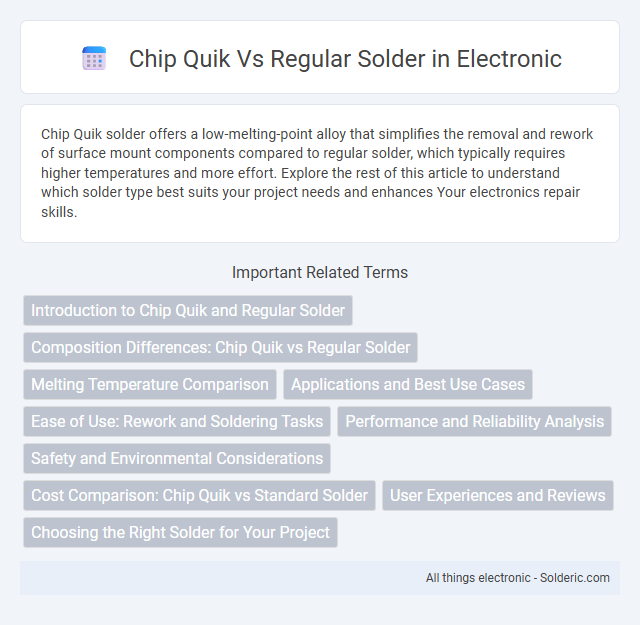Chip Quik solder offers a low-melting-point alloy that simplifies the removal and rework of surface mount components compared to regular solder, which typically requires higher temperatures and more effort. Explore the rest of this article to understand which solder type best suits your project needs and enhances Your electronics repair skills.
Comparison Table
| Feature | Chip Quik | Regular Solder |
|---|---|---|
| Composition | Low-temperature alloy with flux | Lead-based or lead-free alloy with separate flux |
| Melting Point | ~138degC (280degF) | ~183degC (361degF) or higher |
| Use Case | Surface mount component removal and rework | General soldering and assembly |
| Flux | Included in solder paste | Usually requires separate flux application |
| Rework Efficiency | High - easy component removal without damage | Lower - risk of PCB damage during desoldering |
| Temperature Sensitivity | Safer for heat-sensitive components | May damage sensitive parts due to higher heat |
| Cost | Higher per use | Lower per unit |
Introduction to Chip Quik and Regular Solder
Chip Quik is a low-temperature solder designed for easy desoldering and rework, ideal for repairing delicate electronic components without damaging the circuit board. Regular solder typically consists of a tin-lead or lead-free alloy with a higher melting point, used for standard soldering tasks requiring strong, permanent connections. Your choice between Chip Quik and regular solder depends on the application, with Chip Quik favored for precision repairs and regular solder preferred for robust, long-lasting joints.
Composition Differences: Chip Quik vs Regular Solder
Chip Quik solder contains a low melting point alloy blend, typically combining tin, bismuth, lead, and indium, which allows for extended reflow time without damaging components. Regular solder usually consists of a higher melting temperature mixture of tin and lead or lead-free alloys such as tin, silver, and copper. The unique composition of Chip Quik enhances chip removal and rework efficiency by preventing damage during the heating process, whereas standard solder prioritizes durability and joint strength.
Melting Temperature Comparison
Chip Quik solder typically melts at a lower temperature range, around 138degC to 183degC, compared to regular solder which melts between 183degC and 190degC. This lower melting temperature of Chip Quik allows for quicker and safer desoldering processes, reducing the risk of heat damage to sensitive electronic components. Regular solder, while effective for standard soldering, requires higher heat, making Chip Quik a preferred choice for precision repair work.
Applications and Best Use Cases
Chip Quik solder is ideal for intricate electronics repair and rework, particularly on surface mount devices where precise, low-temperature melting is crucial to prevent heat damage. Regular solder, typically containing higher melting point alloys like tin-lead or lead-free blends, suits general-purpose soldering on through-hole components and standard circuit assemblies requiring stronger mechanical joints. In applications demanding quick desoldering and component replacement, Chip Quik's low-melting alloy enables efficient heat transfer and minimal PCB stress, whereas regular solder is preferred for durable, permanent connections in robust electronic manufacturing.
Ease of Use: Rework and Soldering Tasks
Chip Quik solder offers superior ease of use for rework and soldering tasks due to its low melting point alloy, which allows components to be removed quickly without damage. Unlike regular solder, which requires higher temperatures and repeated reheating that can harm delicate parts, Chip Quik maintains a liquid state longer, giving you more control during repairs. This property significantly reduces the risk of thermal stress on components, making your rework process more efficient and less frustrating.
Performance and Reliability Analysis
Chip Quik solder offers superior performance due to its low melting point alloy composition, reducing thermal stress during soldering and protecting delicate components. Its reliable flux formulation enhances wetting and prevents oxidation, resulting in stronger, cleaner solder joints compared to regular solder. You benefit from improved rework efficiency and long-term joint durability with Chip Quik, especially in precision electronics applications.
Safety and Environmental Considerations
Chip Quik solder offers improved safety by featuring a low melting point alloy that reduces the risk of burns and heat damage compared to regular solder. It typically contains less lead or is lead-free, minimizing exposure to toxic substances and environmental contamination. Proper disposal of Chip Quik solder helps limit hazardous waste, supporting eco-friendly electronics repair practices.
Cost Comparison: Chip Quik vs Standard Solder
Chip Quik solder typically costs more per gram compared to regular solder due to its specialized formula and ease of use for complex repairs. Standard solder, often based on a simple tin-lead or lead-free alloy, offers a more budget-friendly option for routine soldering tasks. Your choice depends on whether the higher initial investment in Chip Quik's time-saving properties justifies the cost for precision work or frequent reworks.
User Experiences and Reviews
Users frequently highlight Chip Quik's superior performance in delicate electronics repair due to its fast melting point and ability to prevent heat damage, which many regular solders lack. Reviews emphasize Chip Quik's ease of use for desoldering components, praising its flux core that improves solder flow and reduces residue. In contrast, regular solder often receives criticism for requiring higher temperatures and causing longer exposure to heat, increasing the risk of board damage during repairs.
Choosing the Right Solder for Your Project
Chip Quik solder offers a low-temperature melting point and enhanced flux formulation, making it ideal for delicate electronic repairs and surface-mount components. Regular solder typically contains a higher melting point alloy such as tin-lead or lead-free alternatives, suited for general-purpose applications requiring stronger mechanical bonds. Selecting the right solder depends on factors like component sensitivity, thermal tolerance, and the complexity of the project to ensure reliable and efficient solder joints.
chip quik vs regular solder Infographic

 solderic.com
solderic.com